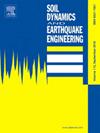Response control of multi-storied adjacent buildings using double-compliant liquid dampers-inerter subjected to seismic excitations
IF 4.2
2区 工程技术
Q1 ENGINEERING, GEOLOGICAL
引用次数: 0
Abstract
Pounding between adjacent, closely spaced buildings was frequently observed in previous major seismic events. This paper proposes a novel double-compliant liquid dampers-inerter (DCLDI) system to mitigate the potential pounding and response of adjacent multi-storied buildings under seismic excitations. Specifically, three configurations of DCLDI are investigated. In Configuration 1, two compliant liquid dampers (CLDs) are linked by the inerter; in Configuration 2, one end of the inerter is connected to the roof of Building 1, while the other end is connected to the CLD, placed at the roof of Building 2; in Configuration 3, one end of the inerter is connected to the CLD, placed at the roof of Building 1, while the other end is connected to the roof of Building 2. Two example benchmark buildings, 4-story and 5-story are taken up for numerical demonstration. The mathematical modelling of the adjacent buildings is done with the shear building multi-degree-of-freedom (MDOF) approximation. The control effectiveness of the proposed damper configurations is investigated in both time and frequency domains. Five parameters of DCLDI are optimized using a single-objective optimization solver, ‘ga’ in MATLAB. The ratio of the relative total energy of the controlled and uncontrolled buildings is chosen as an objective function, while white noise is considered as seismic input. For time domain analysis, 40 recorded seismic ground motions, 20 far-fault, and 20 near-fault are chosen. It is noticed that the optimum DCLDI achieves a maximum reduction in peak acceleration up to 25.3 % for Building 1 and 22.5 % for Building 2, respectively. While DCLDI fails to significantly reduce the maximum inter-story drift ratios and peak displacements, especially in Building 1, under individual earthquakes, the average percentage reductions of the peak responses are modest.
求助全文
约1分钟内获得全文
求助全文
来源期刊

Soil Dynamics and Earthquake Engineering
工程技术-地球科学综合
CiteScore
7.50
自引率
15.00%
发文量
446
审稿时长
8 months
期刊介绍:
The journal aims to encourage and enhance the role of mechanics and other disciplines as they relate to earthquake engineering by providing opportunities for the publication of the work of applied mathematicians, engineers and other applied scientists involved in solving problems closely related to the field of earthquake engineering and geotechnical earthquake engineering.
Emphasis is placed on new concepts and techniques, but case histories will also be published if they enhance the presentation and understanding of new technical concepts.
 求助内容:
求助内容: 应助结果提醒方式:
应助结果提醒方式:


